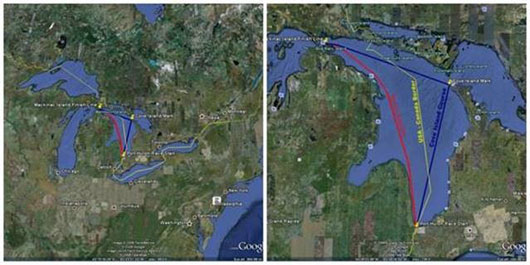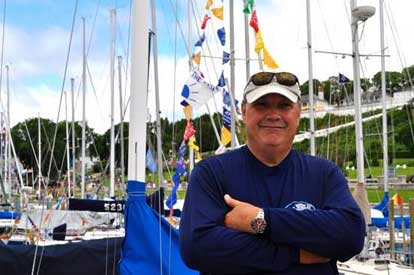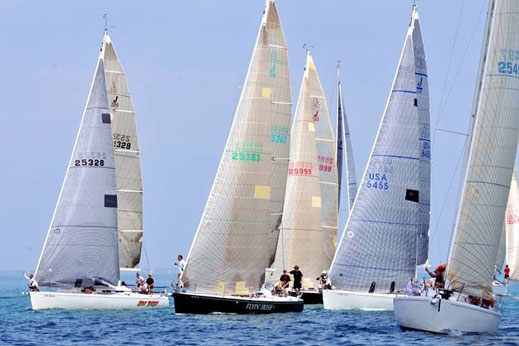
Bell's Beer Bayview Mackinac Race - Adoption of ORR Means Two-for-One Racing on the Great Lakes
Bayview Yacht Clubís Bellís Beer Bayview Mackinac Race, set to start on July 16, is embracing the ORR (Offshore Racing Rule) for the first time. That means thereís no better time for big-boat campaigns to take on the 92nd consecutive edition of the "Bayview Mac" and follow it up with a run at the "Chicago Mac," which starts a week later (July 23) and was an early adopter of ORR.
"Thatís our biggest change this year, that Division I boats sailing the longer Cove Island course (259 nautical miles) will require an ORR rating," - said Bellís Beer Bayview Mackinac Race Chairman Kyle Burleson. "We believe this will provide a better product for the bigger, faster boats looking for something more technological than sailing under PHRF." (Smaller boats are likely to choose the option of sailing the shorter Shore Course of 204 nautical miles under PHRF; if they choose the longer course, they must have an ORR rating.)

Overview and close-up of the Cove Island and Shore Course for the Bellís Beer Bayview Mackinac Race.
The Bellís Beer Bayview Mackinac Race, which starts at the southern end of Lake Huron, and the Chicago Mac, which starts from southern Lake Michigan, are two of the most reputable annual distance races in the U.S. Always run back-to-back, they alternate "going first" and both run south to north to finish at Mackinac Island, which lies near the only waterway that connects these two Great Lakes. "Whichever of the races goes second usually gets the surge in entries," - said Burleson, "basically because the boats are halfway to the second start once theyíve done the first race and get to Mackinac Island. Weíre hoping, however, that the ORR pull will be strong enough to bring more Chicago boats to join us for our start this year; if we can match last yearís numbers (237 boats) that would be incredible."
Whatís in a Name, Anyway?
AMERICAP, IMS, HPR, IRC, ORC, PHRF, ORRÖthe acronyms sound like makings for a hearty bowl of alphabet soup, but instead they are the various sailing handicap rules that have been tried (some successfully and some not so) over the last decade or more to allow sailboats of different designs to race on an equal par. For 2016, the Bellís Beer Bayview Mackinac Race will maintain longstanding PHRF racing on its shorter Shore Course while replacing PHRF with ORR on its longer Cove Island Course. The event organizers decided to adopt the rule after seeing it successfully used in other distance races such as Chicago Mac and Newport to Bermuda.
According to Detroitís Frank Kern, who has won both the Bayview and Chicago Macs with his J/120 Carinthia and is a proud "Old Goat" (a designation for those sailors having more than 25 Bayview to Mackinac races under their sailing belts), both rules take into account various configurations and measurements of hulls and sails, with PHRF additionally taking into account a teamís racing results Ė like a golf handicap.

Frank Kern at Mackinac Island: he has won both the Bayview and Chicago Macs
with his J/120 Carinthia and is a member of the ORR Committee. (Photo credit Carol Kern)
"If somebody has old sails, an unscrubbed bottom and they donít sail well, it will show up in their corrected finish times," he explained. "With ORR, on the other hand, it assumes you have good sails, a clean bottom and good crew. It uses a velocity prediction program to scientifically calculate the rating, using the boatís configurations and measurements to figure out how fast it should be in any different wind range or wind direction. "
Kern knows a thing or two about ORR, because he has been on the ORR Committee Ė comprised of prominent sailors and professionals in the sport Ė helping to vet and promote the rule since soon after the Offshore Racing Association was formed in 2004.
"ORR doesnít take the win record into consideration; it just says how fast the boat should be, and neither the ORR Committee nor the Board Members know specifically the formula used for it. Itís a black box rule: an engineering term meaning you put data in and data comes out, but you donít know whatís in the box. That is only for the ORR technical director to know."

The J/120s will sail the Cove Island Course as a One-Design class while also
competing under the ORR rule for the coveted J.L. Hudson Trophy
(Photo credit Bayview Yacht Club/Martin Chumiecki)
Kern further explained that the ORR works with organizers to understand prominent conditions for their races. "The Transpac is mainly downwind, so thereís an adjustment for that," he said. "Chicago takes two numbers Ė one more downwind and then an all-purpose number, and the Race Committee declares which one they will use the Friday night before Saturdayís start, according to the weather forecast. The Bayview Mackinac has more reaching and upwind tendencies than Chicago, so that will surely be considered."
When all the acronyms for handicap rules are said and understood, itís not about which is which or might be better than another. Itís about PHRF being good for many teams and ORR being the hot new trend for others. And what matters most is that the Bellís Beer Bayview Mackinac Race Ė a race that, with a history of 92 years, is as challenging as it is legendary Ė is offering both options. (There is also the GLMRA rule for the raceís robust multihull contingent, but thatís another story for another time.)
"The overall effect of ORR on the Bayview race is that boats coming from other jurisdictions that want to do both the Bayview Mac and Chicago Mac will find it more convenient to have one rule apply," - said Kern, who not surprisingly will sail both races with his ORR-rated 40 footer. At Bayview, he will specifically sail the ORR-only Cove Island Course, in hopes of not only winning his class (which he expects will be sailed one-design against up to twelve other J/120s) but also taking home the coveted J.L. Hudson Trophy, which he won once before in 2007 and now will be prestigiously designated as top prize for ORR.
Said Kern: "My name is on it, and I consider it one of my finest accomplishments."
For the Bellís Beer Bayview Mackinac Race NOR, go to www.bycmack.com and click the "Documents/Forms" tab. To register, click here.
Joining Bellís Beer in sponsoring the 2015 Bellís Beer Bayview Mackinac Race is the Grand Hotel in Mackinac Island, Mich., Soaring Eagle Casino & Resort, Aitken and Ormand Insurance, Sheplerís Mackinac Island Ferry, Titoís Handmade Vodka, Pentastar Aviation, and the Bayview Yacht Club Foundation.
More About Bayview Yacht Club
Bayview Yacht Club, founded in 1915, is widely regarded as the premier sailing club in Michigan and the Midwest. Located on the Detroit River near the mouth of Lake St. Clair, it has been hosting the Bayview Mackinac Race since 1925 and has more than 1,000 members.
For more information: www.byc.com.
TOP
|